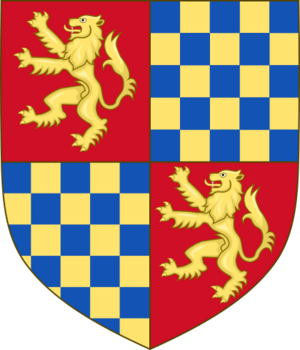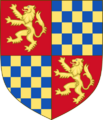Richard Fitzalan, 3rd Earl of Arundel facts for kids
Quick facts for kids Richard Fitzalan |
|
|---|---|
| Earl of Arundel Earl of Surrey |
|

The memorial effigy of Richard Fitzalan and his second wife Eleanor of Lancaster in Chichester Cathedral
|
|
| Born | c. 1313 Sussex |
| Died | 24 January 1376 (age 62/63) Sussex |
| Spouse |
|
| Family | FitzAlan |
| Father | Edmund Fitzalan, 2nd Earl of Arundel |
| Mother | Alice de Warenne |
Richard Fitzalan, also known as the 3rd Earl of Arundel and 8th Earl of Surrey, was an important English nobleman. He lived from about 1313 to January 24, 1376. Richard was a skilled military leader and a respected admiral during the Middle Ages. He was one of the richest nobles in England and a very loyal supporter of King Edward III of England.
Contents
Early Life and Family Background
Richard Fitzalan was born around 1313 in Sussex, England. He was the oldest son of Edmund Fitzalan, 2nd Earl of Arundel, and his mother was Alice de Warenne. His parents married after 1304. Richard's family was well-connected and powerful.
Becoming a Leader
Around 1321, Richard's father became an ally of King Edward II of England's close friends, the Despensers. Richard was married to Isabel le Despenser, the daughter of one of these powerful men. However, things changed quickly, and Richard's father was executed in 1326.
Richard did not immediately inherit his father's lands or titles. But by 1330, the political situation had improved. Over the next few years, Richard slowly got back the Earldom of Arundel and the large estates his father had owned in Sussex and Wales.
Richard also took on important government roles. In 1334, he became the Justiciar of North Wales, a position he later held for life. He was also made Constable of Portchester Castle and Governor of Caernarfon Castle. He was a trusted helper for Edward the Black Prince in Wales.
Fighting for England
Even with his important jobs in Wales, Richard Fitzalan spent a lot of time fighting. He fought in Scotland during the Second Wars of Scottish Independence and in France during the Hundred Years' War.
In 1337, Richard became a joint commander of the English army in the north. The next year, he became the sole commander. He was a brave soldier and fought in many important battles.
Richard Fitzalan was also a distinguished admiral. In 1340, he was made the Admiral of the West. He commanded a large fleet of 70 ships. That summer, he joined King Edward III on the flagship Thomas and sailed to Flanders.
Richard fought bravely at the Battle of Sluys in July 1340. His ship, a large cog, even grappled with a Spanish ship during the fight. This battle was a big victory for England.
After this, he continued to serve in military campaigns. In 1345, he was again made Admiral of the Western Fleet. He was one of the three main English commanders at the famous Battle of Crécy. His experience was very important to the outcome of this battle. Richard's division was on the right side of the battle lines, protected by archers and stakes.
He also fought in a naval battle in 1350, where English ships chased a Spanish fleet. Later in his life, in 1375, he helped destroy the harbor of Roscoff.
| Ship | Master |
|---|---|
| Thomas | William Passelewe |
| Robert Shipman, constable | |
| Edward | William Piers |
| Jonette | Walter Langdale |
| Plenty | John Wille |
| Isabella | John Ram |
| Gabriel | John Rokke |
| Michael | John Maikyn |
| Welfare | John Stygey |
| Mariote | |
| Jerusalem | |
| Thomas Beauchamp | |
| Mary | |
| Godibiate | |
| John | |
| Edmund | |
| Falcon | |
| Buchett | |
| Lawrence |
Great Wealth and Influence
In 1347, Richard inherited the Earldom of Surrey, which made him even wealthier. He became one of the richest nobles in England. He even lent large sums of money to King Edward III of England. When he died, he still had a huge amount of money saved. He was very smart with his finances and made sure his family's wealth would last for future generations.
Marriages and Family
Richard Fitzalan married twice.
First Marriage
His first marriage was on February 9, 1321, to Isabel le Despenser. Richard was about seven years old and Isabel was eight at the time of their marriage. Later, this marriage was ended by the Pope in 1344 because Richard had been too young and unwilling when he married.
Richard and Isabel had one son:
- Sir Edmund de Arundel (born around 1329). After his parents' marriage was ended, Edmund was no longer considered the legal heir to the earldom. He became a knight and owned many lands. He fought in military campaigns in France.
Edmund had three daughters:
- Elizabeth (or Alice) de Arundel, who married Sir Leonard Carew.
- Philippa de Arundel (died 1399), who married Sir Richard Sergeaux.
- Katherine de Arundel, who married Robert Deincourt.
Second Marriage
On April 5, 1345, Richard married Eleanor of Lancaster. She was a young widow and the daughter of Henry, 3rd Earl of Lancaster. King Edward III himself attended this wedding.
Richard and Eleanor had three sons and three daughters who survived:
- Richard Fitzalan, 4th Earl of Arundel, who inherited his father's titles.
- John Fitzalan, 1st Baron Arundel, who was a Marshall of England.
- Thomas Arundel, who became the Archbishop of Canterbury, a very important church leader.
- Joan Fitzalan (1347 – 1419), who married Humphrey de Bohun, 7th Earl of Hereford. They were the grandparents of King Henry V of England.
- Alice FitzAlan (1350 – 1416), who married Thomas Holland, 2nd Earl of Kent. She was an ancestor to several English queens.
Death and Legacy
Richard Fitzalan died on January 24, 1376, at Arundel Castle. He was either 62 or 63 years old. He was buried in Lewes Priory. In his will, he made sure his children from his second marriage were well taken care of. He also asked for the Fitzalan Chapel to be built at Arundel Castle, which his son later did.
Richard Fitzalan was an incredibly wealthy man. He was known for being smart in business and in politics. He carefully managed his money, ensuring his family's future. The memorial statues of Richard Fitzalan and his second wife, Eleanor of Lancaster, in Chichester Cathedral are famous and even inspired a poem called "An Arundel Tomb" by Philip Larkin.
Images for kids
See also
 In Spanish: Richard FitzAlan, X conde de Arundel para niños
In Spanish: Richard FitzAlan, X conde de Arundel para niños
- "An Arundel Tomb"
- Edward III of England
- Edward the Black Prince
- Admiral of the West
- Battle of Crécy
- Battle of Winchelsea
- Battle of Sluys
Sources
- Bradbury, Jim (2011). The Medieval Archer. Woodbridge.
- Weis, Frederick Lewis. Ancestral Roots of Certain American Colonists Who Came to America Before 1700.
- Rodger, N.A.M. (1997). The Safeguard of the Sea: A Naval History of Britain. 1 660-1649. London: Harper Collins.
- Barber, Edward (1978). Edward, Prince of Wales and Aquitaine: A Biography of The Black Prince. Woodbridge. ISBN 9780684158648. https://archive.org/details/edwardprinceofwa00barb.
- Burne, Alfred H. (2005). The Hundred Years War: A Military History. 2 vols. London.
- Given-Wilson, C. (1991). "Wealth and Credit, Public and Private: The Earls of Arundel 1306–1397". English Historical Review 106 (418): 1–26. doi:10.1093/ehr/CVI.CCCCXVIII.1.
| Peerage of England | ||
|---|---|---|
| Preceded by Edmund Fitzalan |
Earl of Arundel 1331–1376 |
Succeeded by Richard Fitzalan |
| Preceded by John de Warenne |
Earl of Surrey 1347–1376 |
|




